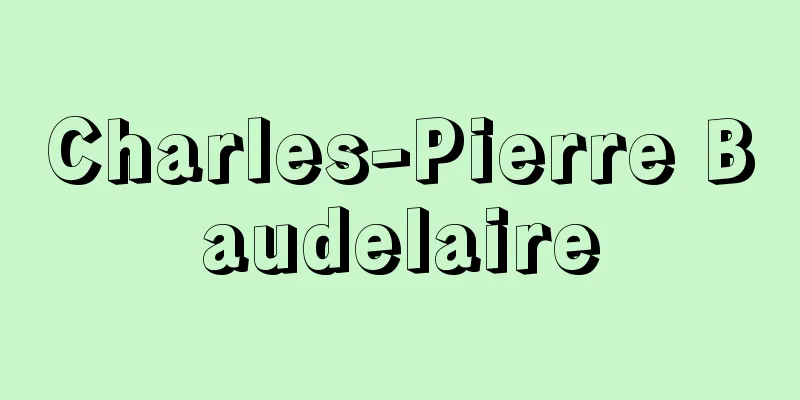Charles-Pierre Baudelaire

|
French poet and critic. [Makoto Yokobari] Indulgence and humiliationBorn in Paris on April 9th. His father, Joseph-François Baudelaire, born in 1759, was a priest until 1793, and before the revolution he served as a private tutor for a nobleman, interacting with the liberal aristocracy who supported Enlightenment philosophy. During the First Empire, he worked in the Senate Secretariat and was also an amateur painter. His father died in 1827, and the following year his mother remarried at the age of 35 to army major Jacques Aupick (1789-1857). Baudelaire received his education at the Royal School of Liberal Arts in Lyon (1832-36) and then at the Louis-le-Grand School of Liberal Arts in Paris, until he was expelled in the spring of 1839. After receiving his baccalauréat (university entrance qualification) in the summer of the same year, he enrolled in law school, but led a dissolute lifestyle and contracted syphilis. In June 1841, a family council decided to have him board a steamer bound for Calcutta (now Kolkata) to change his dissolute lifestyle with his bad friends, a group of young writers. However, he refused to continue the voyage once he reached Bourbon Island (now Reunion Island), and did not reach India. He returned home in February 1842 and immediately returned to Paris. Soon after coming of age, he inherited his father's estate, lived the life of an elegant dandy, and accumulated a large amount of debt. Around the same time, he began a long-term relationship with Jeanne Duval, a mixed race actress. At the request of his mother, who was terrified by her son's extravagant lifestyle, the court applied for judicial guardianship to extravagant spenders in September 1844. The guardian was to hand over to him the interest on the remaining amount of his inheritance each month, and he was forced to live in poverty thereafter. [Makoto Yokobari] Creative ActivitiesIt is said that he had already written a dozen poems for "Les Fleurs du Mal" by 1843, but in 1845 he published "The Salon of 1845," marking his debut as an art critic. The following year, in "The Salon of 1846," he praised Delacroix, discussed the essence of romantic art, and preached the "heroism of modern life," thus developing the aesthetics of realism painting. In 1847, he published his autobiographical novella "La Fanfarlo" in a magazine, and around this time he became devoted to Edgar Allan Poe. As early as the following year and into the 1850s, he published many French translations of Poe's works, including the collection of stories "Les tales extraordinary" (1856). He was interested in the revolutionary ideas of Proudhon and others, and took up arms in the February Revolution and the June Uprising in 1848, but his enthusiasm for direct political activities cooled after the coup d'état in 1851, and he began to take an interest in Joseph de Maistre, a radical Catholic counter-revolutionary thinker. From 1852 to 1854, he sent anonymous love letters with poems to Mme Sabatier, a banker's mistress, and from 1854 he wrote poems inspired by his relationship with the actress Marie Daubrun. In 1857, he published the first edition of his collection of poems, Les Fleurs du Mal, but was fined along with the publisher Poulet-Malassis (1825-1878) and De Broise (1821-1906) for violating public morals and was ordered to delete six poems from the collection. In 1859, he published The Salon of 1859 in a magazine, in which he argued that the imagination, "the queen of the human faculties," has absolute superiority in artistic creation. The following year, he published Artificial Paradise, which included "Poems on Hashish" and "An Opium Addict" (an adaptation of De Quincy's Confessions of an Opium Addict). In 1861 he published the second edition of "Flowers of Evil", and shortly after the failure of the Paris premiere of Wagner's "Tannhäuser", he published a pamphlet entitled "Richard Wagner and the Paris Performance of 'Tannhäuser'". At the end of the same year he ran for admission to the Académie Française, but withdrew his candidacy early the following year due to the disapproval of his friends. In 1862 he published 20 prose poems in newspapers under the general title "Peter Prose Poems". In 1863 he published "The Works and Life of Eugène Delacroix" in memory of Delacroix, followed by "Painter of Modern Life", a discussion of genre painter Constantin Guise. The latter, which advocates the value of beauty in "transient things", moves him away from realism and towards impressionism, and also serves as a manifesto for the aesthetics of prose poetry that he was working on at the time. In 1864, he set off on a lecture tour to Belgium in order to escape creditors and in hopes of signing a publishing contract for his complete works, but the contract fell through and his lectures were poorly received. In March 1866, while visiting the Saint-Loup Church in Namur, Belgium, he collapsed, suffering from right-sided paralysis and aphasia. He returned to Paris in July and was hospitalized, dying on August 31, 1867, at the age of 46. He is buried in Montparnasse Cemetery. His posthumous works include the aphoristic "The Rocket" (written 1855-62), "The Naked Heart" (written 1859-66), and "Poor Belgium" (draft), a satirical critique of civilization. [Makoto Yokobari] evaluationAlthough Baudelaire was a latecomer to the genre as a radical romantic, and was too far ahead of his time in upholding modernity and advocating the aesthetics of urban life, he was ultimately forced to suffer from the incomprehension of his contemporaries and lived a life plagued by poverty and loneliness. However, with his unique lyricism supported by a penetrating critical spirit directed at himself and his objects, he was not only an intellectual poet who built the foundations of modern poetry in general after Symbolism, and an art critic who contributed to the establishment of modern painting and clearly set the direction for subsequent criticism, but also a critic of civilization who astutely sensed the crisis in modern society and mercilessly criticized it. [Makoto Yokobari] "The Complete Works of Baudelaire, translated by Fukunaga Takehiko et al., four volumes (1963-64, Jinbun Shoin)" ▽ "The Complete Works of Baudelaire, translated by Abe Yoshio, six volumes (1983-, Chikuma Shobo)" ▽ "Parisian Melancholy: Baudelaire and His Times, by Kawamori Yoshizo (1978, Kawade Shobo Shinsha)" ▽ "The Artist in the Crowd: Baudelaire and 19th Century French Painting, by Abe Yoshio (1975, Chuokoron-Shinsha)" [References] | |Source: Shogakukan Encyclopedia Nipponica About Encyclopedia Nipponica Information | Legend |
|
フランスの詩人、批評家。 [横張 誠] 放縦と屈辱4月9日パリに生まれる。1759年生まれの父ジョゼフ・フランソア・ボードレールは、93年まで僧職にあり、革命前は大貴族の家庭教師を務め、啓蒙(けいもう)哲学の立場をとるリベラルな貴族階級と交流があった。そして第一帝政下では元老院事務局に勤務し、アマチュアの画家でもあった。1827年父は没し、翌年母は35歳で陸軍少佐ジャック・オーピックJacques Aupick(1789―1857)と再婚。ボードレールはリヨンの王立中学(1832~36)、ついでパリのルイ・ル・グラン中学で、39年春放校となるまで教育を受け、同年夏バカロレア(大学入学資格)を取得後、法律学校に登録したものの放縦な生活を送り、梅毒に感染する。親族会議の決定により、悪友の文学青年たちとの放埒(ほうらつ)な生活を改めさせるため、41年6月カルカッタ(現コルカタ)行き汽船に乗船させられるが、ブールボン島(現レユニオン島)まで行って航海を続けることを拒否、インドには至らず、42年2月帰国、ただちにパリへ戻る。まもなく成年に達し、実父の遺産を相続、優雅なダンディの生活を送り、多額の負債をつくる。同じころ、黒白混血の端役女優ジャンヌ・デュバルJeane Duvalとの長年にわたる関係が始まる。息子の濫費生活に恐れをなした母親の願い出に基づき、44年9月、裁判所により浪費者に対する裁判上の保佐制度の適用が決定され、遺産の残額の利子のみを保佐人から月々手渡されることとなり、以後困窮生活を強いられる。 [横張 誠] 創作活動すでに1843年ころには『悪の華』の詩編が十数編できていたと伝えられるが、45年『1845年のサロン』を発表、まず美術批評家としてデビューする。翌年『1846年のサロン』ではドラクロワを賞賛し、ロマン主義芸術の本質を論ずるとともに、「現代生活の英雄性」を説くことにより、すでにリアリズム絵画の美学を展開する。47年には自伝的中編小説『ラ・ファンファルロ』を雑誌に掲載、このころからエドガー・アラン・ポーに傾倒し、早くも翌年から50年代にかけて、小説集『異常な物語』(1856)など、ポーの作品の仏訳を多数発表する。プルードンなどの革命思想に興味を抱いて、48年の二月革命、6月蜂起(ほうき)には武器を取って参加するが、51年のクーデターを機に、直接的な政治活動への熱が冷め、過激なカトリックの反革命思想家ジョゼフ・ド・メーストルに関心をもち始める。52年から54年にかけて、銀行家の愛人サバティエ夫人Mme Sabatierに匿名で詩を添えた恋文を送り、54年からは女優マリー・ドーブランMarie Daubrunとの交渉から想を得て詩を書く。57年詩集『悪の華』初版を刊行、公衆道徳良俗侵害のかどで、刊行者プーレ・マラシPoulet-Malassis(1825―78)、ド・ブロワーズDe Broise(1821―1906)とともに罰金刑の判決を受け、詩集中の六編の削除を命令される。59年、「人間の諸能力の女王」たる想像力が芸術創造において絶対的優位にたつことを説いた『1859年のサロン』を雑誌に発表、翌年、「ハシッシュの詩」「ある阿片(あへん)常用者」(ディ・クウィンシーの『阿片常用者の告白』の翻案)を収録した『人工天国』を刊行する。 1861年『悪の華』第二版を出版、また、ワーグナーの『タンホイザー』パリ初演が失敗に終わってまもなく、『リヒャルト・ワーグナーと「タンホイザー」パリ公演』と題する小冊子を刊行。同年末アカデミー・フランセーズに立候補するが、友人たちのひんしゅくを買って翌年初め取り下げる。62年、散文詩20編を『小散文詩』の総題のもとに新聞に分載発表。63年、ドラクロワを追悼して『ウージェーヌ・ドラクロワの作品と生涯』を、ついで風俗画家コンスタンタン・ギースを論じた『現代生活の画家』をそれぞれ新聞に発表したが、後者は、「うつろいやすいもの」の美の価値を説く点で、リアリズムから印象主義への方向づけを行うものであるとともに、当時自ら書き進めていた散文詩の美学のマニフェストともなっている。64年、債権者から逃れるためと、全集の出版契約のもくろみもあって、ベルギーへ講演旅行に出発、しかし契約は失敗、講演は不評に終わる。66年3月、ベルギー、ナミュール市のサン・ルー教会を見物中倒れ、右半身不随、失語症の症状を呈し、7月パリに戻り入院、翌67年8月31日没。46歳。モンパルナス墓地に埋葬される。遺稿として、アフォリスム的な『火箭(ひや)』(1855~62執筆)、『赤裸の心』(1859~66執筆)や、風刺的な文明批判の書『哀れなベルギー』(草稿)がある。 [横張 誠] 評価ボードレールは、遅れてやってきた過激なロマン主義者としても、現代性を掲げ都市生活の美学を提唱して、時代を先取りしすぎたことによっても、結局、同時代の無理解に自ら苦しまねばならず、貧困と孤独にさいなまれた生涯を送った。しかし、自己と対象に向けられた透徹した批判精神に支えられた独特の叙情をもって、象徴主義以後の近代詩全般の基礎を築いた知的詩人であり、近代絵画の成立に寄与し、さらに、その後の批評のあり方を明確に方向づけた美術批評家であったにとどまらず、近代社会の危機を明敏に感じ取り、容赦なく批判した文明批評家でもあった。 [横張 誠] 『福永武彦他訳『ボードレール全集』全四巻(1963~64・人文書院)』▽『阿部良雄訳『ボードレール全集』全六巻(1983~・筑摩書房)』▽『河盛好蔵著『パリの憂愁――ボードレールとその時代』(1978・河出書房新社)』▽『阿部良雄著『群衆の中の芸術家――ボードレールと19世紀フランス絵画』(1975・中央公論社)』 [参照項目] | |出典 小学館 日本大百科全書(ニッポニカ)日本大百科全書(ニッポニカ)について 情報 | 凡例 |
<<: Port wine - Port (English spelling)
Recommend
Kissuiin Soshin Hoin
…It is located on Mount Yoshino in Yoshino-cho, Y...
Bunmei Ittouki - Bunmei Ittouki
This book on politics was written by Ichijo Kaney...
cycle
〘noun〙 (cycle)① A unit of vibration or frequency. ...
redirected behavior
The zigzag dance of sticklebacks is a good exampl...
Albedo (English spelling)
The proportion of light reflected by the surface o...
Meganeura - Meganeura
Meganeura is also read as Meganeura. It is a foss...
Sphagnum moss - Sphagnum moss
A general term for the moss genus Sphagnum in the ...
Genkyoku Taishinsho - Genkyoku Taishinsho
Jiuta sangen score. Only the first volume of the t...
Transesterification reaction - Transesterification reaction
…(4) Reacting silver carboxylate with an alkyl ha...
Mutina
...Located in the southern part of the Po Plain a...
Motif (English spelling)
It is translated as motive or motivation. It is a ...
Ommatophoca rossi (English spelling) Ommatophocarossi
…A general term for four species of mammals in th...
Agricultural infrastructure development
This refers to the planned development of the agri...
Ross, MD
...Balloons, which were used primarily for advent...
Catenary current meter - Catenary current meter
A type of ammeter. It indirectly measures current ...









